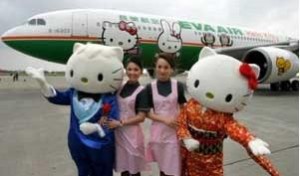
Hello Kitty is one of the most recognizable characters of Japanese cool. Created in 1974, Kitty-chan merchandise has been marketed worldwide to children and adults alike, and she was recently named the Ambassador of Tourism for Japan. So what is so special about this kitty? What exactly are Americans consuming when we take part in the Kitty Boom? Are we buying Japan, or is it just cute?
In order to determine how and why we consume this cute cat, it is important to analyze how we read Hello Kitty in an American context. In the United States , Hello Kitty is marketed almost primarily in the form of material goods. Unlike other Japanese toys, Hello Kitty lacks a detailed background story, and she is without an ongoing adventure or plot. She is, in a sense, not a kitty, but rather an image—one that has done remarkably well in replicating itself to sell all sorts of goods, from baby bottles to handbags to vibrators. Hello Kitty is a product of late capitalism: she is the postmodern cat.
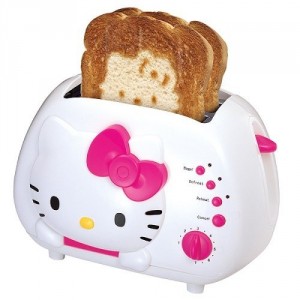 As a character, Hello Kitty functions as a simulacrum. Defined by Baudrillard, the presence of the simulacrum is a postmodern affliction in which the image, instead of representing reality, begins instead to replace the real. He writes, “Simulation… is the generation by models of a real without origin or reality: a hyperreal” (Baudrillard 389). Hello Kitty material goods exemplify the simulacrum, in the sense that they are all “copies of copies of the same commodified image with no apparent original (McVeigh, 232). Hello Kitty has no fairy tale to which the consumer can refer: there is no ‘reality’ of a story behind her image. In an article praising Kitty-chan’s longevity as a product, Leo Lewis explains that “she is not a manga spin-off like Dragon Ball, a game spin-off like Pokémon or an anime spin off like Gundam” (14). Hello Kitty has thus achieved fame solely as an image, an image which has proven extremely capable of replicating itself for consumption (Lewis 14).
As a character, Hello Kitty functions as a simulacrum. Defined by Baudrillard, the presence of the simulacrum is a postmodern affliction in which the image, instead of representing reality, begins instead to replace the real. He writes, “Simulation… is the generation by models of a real without origin or reality: a hyperreal” (Baudrillard 389). Hello Kitty material goods exemplify the simulacrum, in the sense that they are all “copies of copies of the same commodified image with no apparent original (McVeigh, 232). Hello Kitty has no fairy tale to which the consumer can refer: there is no ‘reality’ of a story behind her image. In an article praising Kitty-chan’s longevity as a product, Leo Lewis explains that “she is not a manga spin-off like Dragon Ball, a game spin-off like Pokémon or an anime spin off like Gundam” (14). Hello Kitty has thus achieved fame solely as an image, an image which has proven extremely capable of replicating itself for consumption (Lewis 14).
But wait– Hello Kitty does have a story, right? She is from London, and lives there with whole slew of Kitty family members, at least according to McGray’s description of the complexity of her origins in his article on Japan’s Gross National Cool. Although Sanrio has created multiple story lines for Hello Kitty and her Friends, the timing of these spin-offs is crucial. Hello Kitty, before she ever had a story, had retail.
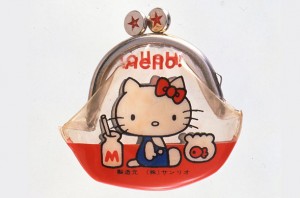 Sanrio marketed Hello Kitty products long before her background story and its subsequent children’s newspaper, video games, or television series, were ever released. The first Hello Kitty product marketed in Japan was actually a small coin purse: a telling object for an image based solely on consumption. McVeigh quotes Ben Hensley, a marketing manager for Sanrio based in San Fransisco: “’We’re the leader in the retail-first strategy of creating characters to be on products’” (232).
Sanrio marketed Hello Kitty products long before her background story and its subsequent children’s newspaper, video games, or television series, were ever released. The first Hello Kitty product marketed in Japan was actually a small coin purse: a telling object for an image based solely on consumption. McVeigh quotes Ben Hensley, a marketing manager for Sanrio based in San Fransisco: “’We’re the leader in the retail-first strategy of creating characters to be on products’” (232).
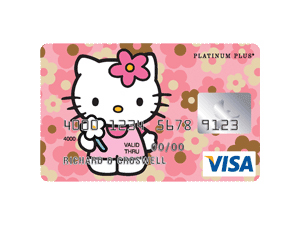 This strategy of retail-first is just as it sounds: Sanrio creates merchandise branded with a character before ever inventing a storyline to accompany the image. This marketing strategy exemplifies the simulacrum. In a late-capitalist society in which consumption itself becomes a value, the image no longer needs to reference an original. Hello Kitty, in Japan, the United States, and the rest of the world, is consumed primarily as this image.
This strategy of retail-first is just as it sounds: Sanrio creates merchandise branded with a character before ever inventing a storyline to accompany the image. This marketing strategy exemplifies the simulacrum. In a late-capitalist society in which consumption itself becomes a value, the image no longer needs to reference an original. Hello Kitty, in Japan, the United States, and the rest of the world, is consumed primarily as this image.
 As a character that lacks an original story, Hello Kitty seems to embody the mukokuseki style of Japanese products marketed abroad. Koichi Iwabuchi claims that much of the “soft” technology exported from Japan appears mukokuseki, or nationless, in its aesthetic and is thus more accessible to consumers outside of Japan. Much of anime has been described in this way because it’s central plot takes place in a fantastic land instead of being based in a representation of Japan, which would give it a more Japanese “cultural odor.” The character of Hello Kitty takes nationlessness to the next level: lacking any ongoing story, she cannot trouble the consumer with complications of cultural specificity. As an image, in fact, Hello Kitty seems capable rather of taking on the odor of any location, style, age group, or social class.
As a character that lacks an original story, Hello Kitty seems to embody the mukokuseki style of Japanese products marketed abroad. Koichi Iwabuchi claims that much of the “soft” technology exported from Japan appears mukokuseki, or nationless, in its aesthetic and is thus more accessible to consumers outside of Japan. Much of anime has been described in this way because it’s central plot takes place in a fantastic land instead of being based in a representation of Japan, which would give it a more Japanese “cultural odor.” The character of Hello Kitty takes nationlessness to the next level: lacking any ongoing story, she cannot trouble the consumer with complications of cultural specificity. As an image, in fact, Hello Kitty seems capable rather of taking on the odor of any location, style, age group, or social class.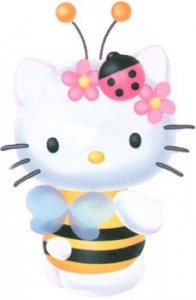
Hello Kitty has a knack for costume, which has most likely contributed to her global success as a product. Her plain image can be seen as a blank canvas on which all sorts of consumers can project their own interpretations of Kitty-chan’s style. McVeigh describes this aspect of Hello Kitty’s character as her “powers of transformation,” citing other Sanrio products such as Mermaid Kitty, Bee Kitty, and Koala Kitty to demonstrate Kitty-chan’s ability to appropriate a variety of styles while still maintaining her expressionless face (233). Hello Kitty does not only appropriate the cuteness of other animals, but can essentially be dressed up in any style in the world.
Exemplifying globalization, Hello Kitty merchandise is always localized. She is supposed to be a British cat, and her English name creates a foreign appeal in the domestic market. In Japan, however, the company Emori has created “200 different ‘localized’ Kitty dolls. Each Japanese prefecture and major city now has its own version of the little cat representing that region’s specialty” (Lewis 15). Marketed abroad, however, Kitty-chan maintains her ‘foreign’ appeal, and Sanrio’s products are similarly localized for every region in which Hello Kitty merchandise is sold (Yano 65). Hello Kitty’s ability to transform her own image into one that fits any context explains her popularity among such a diverse consumer base.

Which image, then, are Americans consuming? Is it the kawaii, or the cute? Is it the Orientalized ‘foreignness’ of this ubiquitous cat? Or is it just sheer consumerism, the availability of a seemingly infinite number of Hello Kitty-branded products, to which American consumers are drawn? For now, Hello Kitty is keeping her mouth shut as she reaps the benefits of Cool Japan.
Sources:
Baudrillard, Jean. “The Precession of Simulacra.” Cultural Theory and Popular Culture: A Reader. Ed. John Storey. Harlow: Pearson Education Limited, 2006. 389-396.
Iwabuchi, Koichi. Recentering Globalization. Durham: Duke University Press, 2002.
Lewis, Leo. “Hello Kitty Turns 30 and Keeps on Growing.” J@pan Inc. 47 (Sept. 2003): 14-15. Academic Search Complete. Swem Library, Williamsburg, Va. 3 April 2010.
McVeigh, Brian J. “How Hello Kitty Commodifies the Cute, Cool, and Camp.” Journal of Material Culture 5.2 (2000): 225-245. Academic Search Complete. Swem Library, Williamsburg, Va. 3 April 2010.
Yano, Christine R. “Kitty Litter: Japanese Cute at Home and Abroad.” Toys, Games, and Media. Ed. Jeffrey Goldstein, David Buckingham, and Gilles Brougére. Mahwah, New Jersey: Lawrence Erlbaum Associates, 2004. 55-71.
Entry contributed by Ingrid Heiberg
Ingrid, your article is spot-on. It’s also pretty to look at, fun, and really interesting. I think you’re right about the reason for Hello Kitty’s longevity. She enjoys enduring popularity because there is no story to her—but there are always new products.
I also think you touch on an interesting point. Hello Kitty seems foreign to the Japanese, and she seems Japanese to everybody else.
You talk about all of Japan’s cute mascots—is there something about Japanese culture that makes them more receptive to cute representations/symbols?
I love the title of this article–initially cute with a businesslike followup (which more or less encompasses the idea of Hello Kitty, doesn’t it?).
I found the simulacrum portion of the article to be the most telling. It seems like Hello Kitty is capitalism in its rawest form–created for sales, given characteristics after popularity arises. And i also found the localization of cute interesting–almost as though Hello Kitty is odorlessness, any odor can be attached to her. I’m just curious, though, do you think if Hello Kitty originated from another nation, it would be as successful as it is today?